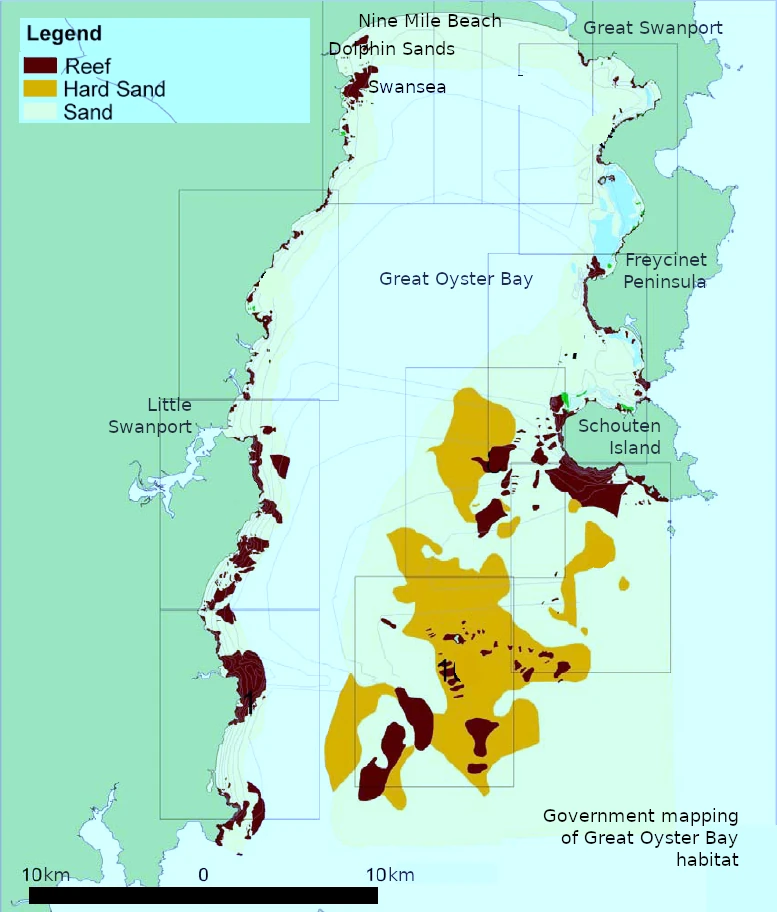
Swansea is located on the north-west shore of Great Oyster Bay, with spectacular Freycinet Peninsula visible the east.
Oyster Bay is a significant fishing location on Tasmanian’s mid East Coast, a little over a two-hour drive from Hobart or Launceston.
The bay was chosen to host two of Tasmania’s first saltwater FADs, installed in 2021.
Species to be caught at and around Swansea include flathead, salmon, KG whiting, garfish, leatherjackets, flounder, bluethroat wrasse, black bream, silver trevally and squid.
Note that much of Great Oyster Bay is a shark reserve, which means sharks and rays may not be taken.
The bay’s waters are reasonably protected from most winds except southerlies.
The upper bay is shallow with a mostly bare sand bottom, with patches of seagrass. There is fringing reef south of Nine Mile Beach.
Most of the bay’s seagrass is found in the shallow depth range of 5m to 12m, and if you are boat fishing for flathead, flounder, KG whiting and squid, this is a good range to concentrate your efforts, fishing deeper on clear days when the fish may spook more easily.
Great Oyster Bay has two significant estuaries feeding the bay, with Greater Swanport north of Swansea being a great producer of black bream, some of which make their way into the bay.
Reef south of Swansea is mainly fringing reef to 10m to 15m depth and usually located less than 250m from shore.
Near Swansea there is a cobble bottom. The western bay shoreline is dominated by dolerite, while the opposite side of the bay (Freycinet) has granite.
There is no reef along Nine Mile Beach on the bay’s northern shore.
Wrasse are usually easily located around reef edges in the bay, and expect occasional snapper, trevally and more in deeper water.
KG whiting can be hard to find within the bay, but usually the edges of seagrass patches are the place to look, with some good KGs caught in the bay by those in the know.
Flathead can be found by drift fishing with bait or jigs run along the bottom, or trolling lures that swim near the bottom.
Being shallow and usually clear, overcast conditions can fish well in the shallow areas.
There are good access points to the bay along the highway on the west side of the bay.
The Swan River just north of Swansea has black bream, including some big fish. There are spots along Dolphin Sands Road that can be fished.
Jetties at Swansea and Coles Bay produce mainly squid, best at dusk and dawn. Sometimes salmon, slimy mackerel, snotties and pike are caught.
Fishos with suitable boats can head south-east from Swansea to offshore grounds around Schouten Island for trumpeter, lobsters and tuna.
Another great East Coast location is St Helens.
Here is a list of recommended tackle for Tasmanian waters.
Swansea tides
Tasmanian FADs
Tasmanian fishing regulations
Tasmanian marine reserves
Tasmanian saltwater fishing seasons
Trout fishing spot access programs
Fisheries assessment reports
Buy a freshwater fishing licence
Tasmanian lake levels (hydro)
Tasmanian river flows (govt)
Bag and size limits
Private Tasmanian trout fisheries
Return to the Tasmanian Fishing Map
Email corrections, additions, pictures or video here.
